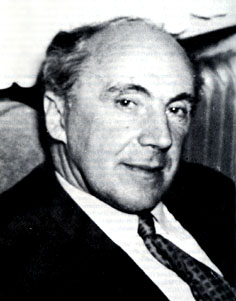Some Biogeographers, Evolutionists and Ecologists:
Chrono-Biographical Sketches
Hultén, Eric Oskar Gunnar (Sweden
1894-1981)
botany, phytogeography
 Photo courtesy of Taxon. |
Eric Hultén was in his time the pre-eminent student of circumboreal floras, and overall one of the greatest of twentieth century plant geographers. Beyond being equally adept as a field biologist, specimen collector, herbarium organizer, literature synthesizer, and plant taxonomist, he was also an important producer of new theories. It was Hultén, for example, who first significantly challenged the earlier view that during the Ice Age most or all circumpolar lands were completely covered with ice and unfit for vegetation: his research led him to hypothesize instead that numerous refugia had existed, a conclusion that has largely proved out through many subsequent researches. Hultén coined the term "Beringia" to describe one particular such refugium he thought existed around the Bering Strait area during the glacial period days of lower sea levels, and the term has stuck and provided a foundation for thinking in an array of related fields. Hultén is also known for his theory of equiformal progressive areas, an elaboration on the "age and area" notion of J. C. Willis in which plants are viewed as changing evolutionarily as they disperse out over time from refugial centers of origin. Several of Hultén's books became classics, including those on his model of Quaternary Arctic floral evolution (1937), his regional surveys of Alaskan vascular plants (1941-1950 and 1968), his dot-map atlas of Scandinavian plant distribution (1950), and his phytogeographical syntheses of far-northern plant life (1958 and 1961). |
Life Chronology
--born in Halla, Sweden, on 18 March 1894.
--1913: begins studies at the University of Stockholm
--1919: Masters degree, University of Stockholm
--1920-1923: member of a botanical expedition to the Kamchatka Peninsula,
Siberia
--1927: member of a botanical expedition to the Kola Peninsula, Northern
Europe
--1931: Ph.D., University of Stockholm
--1931-1944: curator of the herbarium at the University of Lund
--1931-1932: member of a botanical expedition to Mexico
--1932, 1960-1965: takes part in botanical expeditions to Alaska
--1937: D.Sc., University of Lund
--1937: publishes his Outline of the History of Arctic and Boreal
Biota During the Quaternary Period
--1941-1950: publishes his Flora of Alaska and Yukon, in ten
parts
--1945-1961: professor and director of the botany department, Stockholm
Riksmuseum
--1950: publishes his Atlas of the Distribution of Vascular Plants
in Northwestern Europe
--1950-1951: director of the Stockholm Riksmuseum
--1958: publishes his The Amphi-Atlantic Plants and Their Phytogeographical
Connections
--1959: honorary D.Sc., University of Montreal
--1961: publishes his The Circumpolar Plants, in two volumes;
retires from the Stockholm Riksmuseum
--1968: publishes his Flora of Alaska and Neighboring Territories
--1976: suffers a debilitating stroke and is left an invalid
--dies on 1 February 1981.
For Additional Information, See:
--Molecular Ecology, Vol. 12(2) (2003): 299-313.
--Arctic and Alpine
Research, Vol. 13(3) (1981): 357-359.
--Taxon, Vol. 30(3) (1981): 733-736.
--Men Roligt har det Varit
(1973) [Hultén's autobiography, in Swedish].
*
*
*
*
*
Copyright 2005 by Charles H. Smith. All rights
reserved.
http://people.wku.edu/charles.smith/chronob/HULT1894.htm
Return to Home/Alphabetical Listing by Name
Return to Listing by Country
Return to Listing by Discipline